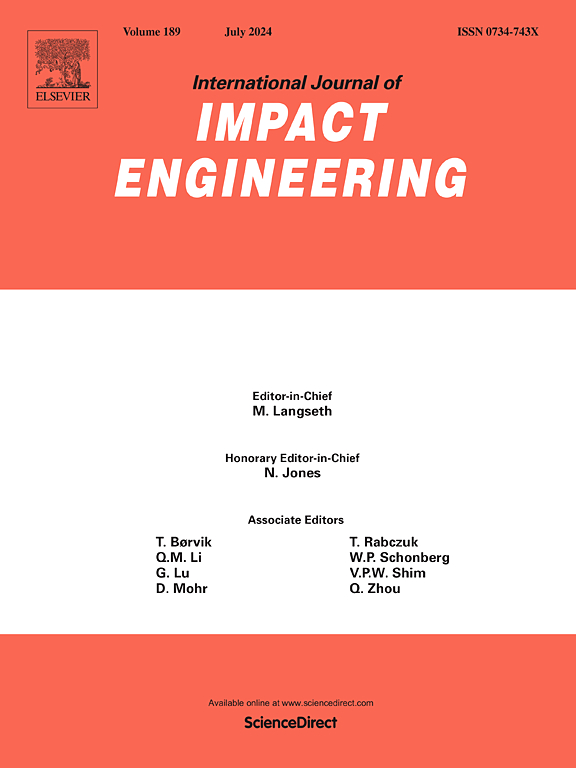超高速对粉末型定向能沉积铝合金/钛合金复合材料的影响
IF 5.1
2区 工程技术
Q1 ENGINEERING, MECHANICAL
International Journal of Impact Engineering
Pub Date : 2025-05-23
DOI:10.1016/j.ijimpeng.2025.105391
引用次数: 0
摘要
增材制造目前正处于快速采用时期,特别是在冲击工程领域。各种增材制造工艺用于制造空间部件和结构。由于空间碎片的轨道速度非常高,超过每秒7公里,因此一旦发生碰撞,造成严重破坏的可能性相当大。为了准备与空间碎片发生意外碰撞的可能性,有必要了解通过增材制造工艺制造的空间部件和结构的超高速碰撞行为。粉末床熔融(PBF)方法是众多增材制造工艺中应用最广泛的方法。研究了用PBF法制备的零件和结构的超高速冲击性能。相比之下,定向能沉积(DED)方法是一种增材制造工艺,具有明显的优势,包括高制造速度、大规模打印能力和功能梯度材料的生产。本研究利用DED机器制备了Al-10Si-0.4Mg合金样品、Ti-6Al-4V合金样品和Al-10Si-0.4Mg / Ti-6Al-4V复合样品。主要采用混合比为80:20 (Al-10Si-0.4Mg: Ti-6Al-4V)的复合材料试样进行强度评价。在确定铝合金弹丸的拉伸性能后,研究了铝合金弹丸的超高速撞击行为,重点研究了弹丸的穿孔、碎片云(弹丸后侧碎片)、后壁(弹丸破碎)和弹丸前侧向后抛射(弹丸破片)等特征。并与Al-10Si-0.4Mg合金试样和Ti-6Al-4V合金试样进行了比较。本文章由计算机程序翻译,如有差异,请以英文原文为准。
Hypervelocity impacts on aluminum alloy/titanium alloy composites fabricated by powder-type directed energy deposition
Additive manufacturing is currently undergoing a period of rapid adoption, particularly in the field of impact engineering. Various additive manufacturing processes are utilized for the fabrication of space components and structures. Because space debris orbit at very high velocities over 7 km/s, the potential for severe damage in the event of a collision is considerable. To prepare for the possibility of an unexpected collision with space debris, it is essential to understand the hypervelocity impact behaviors of space components and structures that are fabricated by additive manufacturing processes. Powder bed fusion (PBF) method is the most widely used among many additive manufacturing processes. The hypervelocity impact behaviors of parts and structures fabricated by the PBF method have been examined. In contrast, the directed energy deposition (DED) method, an additive manufacturing process, offers distinct advantages, including high fabrication speed, large-scale printing capabilities, and the production of functionally graded materials. In this study, the Al–10Si–0.4Mg alloy sample, Ti–6Al–4V alloy sample, and Al–10Si–0.4Mg/Ti–6Al–4V composite samples were fabricated using a DED machine. The composite sample with a mixing ratio of 80:20 (Al–10Si–0.4Mg:Ti–6Al–4V) was primarily utilized for strength evaluation. After the confirmation of their tensile properties, the hypervelocity impact behaviors using aluminum alloy projectiles were examined, with a focus on characteristics such as perforation holes, debris clouds (fragments on the rear side of the target), rear wall (fragmentation of projectiles), and backward ejecta (fragments) from the front side of the target. The results were compared with those of the Al–10Si–0.4Mg alloy sample and Ti–6Al–4V alloy sample.
求助全文
通过发布文献求助,成功后即可免费获取论文全文。
去求助
来源期刊

International Journal of Impact Engineering
工程技术-工程:机械
CiteScore
8.70
自引率
13.70%
发文量
241
审稿时长
52 days
期刊介绍:
The International Journal of Impact Engineering, established in 1983 publishes original research findings related to the response of structures, components and materials subjected to impact, blast and high-rate loading. Areas relevant to the journal encompass the following general topics and those associated with them:
-Behaviour and failure of structures and materials under impact and blast loading
-Systems for protection and absorption of impact and blast loading
-Terminal ballistics
-Dynamic behaviour and failure of materials including plasticity and fracture
-Stress waves
-Structural crashworthiness
-High-rate mechanical and forming processes
-Impact, blast and high-rate loading/measurement techniques and their applications
 求助内容:
求助内容: 应助结果提醒方式:
应助结果提醒方式:


